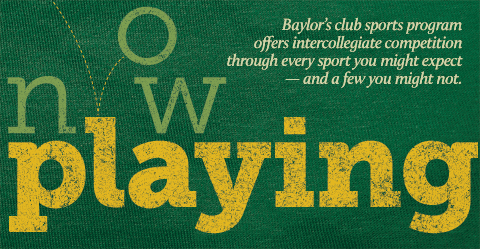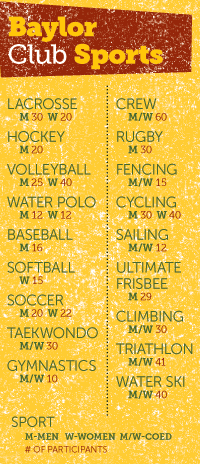Now playing
It's Saturday morning, and a Baylor athlete arrives at the practice field early to work on his passing. He throws and retrieves, throws and retrieves, trying to nail that elusive perfect arc, breaking out in a sweat despite the chill in the morning air. By the time the first of his teammates arrives, he is tired but elated, confident that he won't have many turnovers next weekend.
He retrieves his Frisbee one last time and goes to greet his friends.
Scenes like these play out across the Baylor campus throughout the year, as scores of student-athletes devote their time and talents to teams many in the Baylor family have never heard of. We are all well acquainted with our school's varsity programs: football, basketball, baseball, track, and so on. But many Bears might not know that, in organizations known as club sports, Baylor students participate in an extremely diverse array of sports such as ice hockey, lacrosse and Ultimate Frisbee.
There are currently 24 club sports at Baylor -- as compared with 19 Division I varsity teams. What's the difference?
Dr. Kim Scott, BA '84, BSED '84, MS '86, director of campus recreation, explains, "[Division I] sports must comply with all NCAA regulations, including Title IX, regarding gender equity. Each of these sports has qualified coaches, provides the required number of scholarships and competes in the Big 12 Conference."
By comparison, Scott says, "none of the student-athletes who participate on a club sport are on athletic scholarship. Club sports offer the enjoyment of skills, teamwork and competition without the pressure and time commitment of Division I athletics." They also generally lack professional coaches, relying instead on student coaches or faculty advisors with years of experience playing the sport.
In addition, unlike NCAA sports, many club sports are co-ed. The crew (rowing) team, for example, includes about 60 members, nearly half of whom are women.
But for all their differences, don't let the "club" label fool you into thinking these teams aren't highly competitive. In the last decade alone, several Baylor club teams have stood out on the national scene. In 2002, men's rugby won the national championship. The women's club soccer team competed in the national playoffs in 2008 and 2010. And the women's club volleyball team finished in the top three in the nation each of the last three years. In fact, in recent years, both the varsity volleyball and soccer teams have looked to the club teams on occasion to fill out their rosters due to injuries and other situations.
Club sports are open to any full-time undergraduate or graduate student with a 2.25 or higher grade point average. But beyond that, each club has its own rules and expectations. Some accept all interested applicants; this is especially true of sports that aren't usually offered in high schools, like fencing and sailing. Hasan Dimayuga, a junior and president of the fencing club, welcomes all comers with, "Don't worry, we'll teach you. No experience required."
Other clubs, such as gymnastics, require tryouts and extensive experience. Senior Madeline McClure participated in competitive gymnastics from the age of 3 until she was 14. She now spends about 14 hours a week on activities related to the club team, balancing this commitment with her church activities, a campus job and an off-campus job coaching gymnastics, all while maintaining a rigorous course schedule as a University Scholar.
"Club sports are fantastic," McClure says. "It allows me to keep doing this sport that I love, but without all the pressure of being NCAA. For gymnastics, your 'career' is typically over if you don't get a scholarship -- that's if you can make it through high school gymnastics. That said, we work hard. We push ourselves to our limits."
In addition to the time and effort devoted to practice and competitions -- which, for many of the sports, take up entire weekends -- many clubs face the added responsibility of raising funding to keep their teams operational. Baylor provides some financial support for each club, but there is often a funding gap.
To make up the difference, most clubs collect dues from members. Some also have annual fundraisers, such as the Ultimate Frisbee team's FrisbeeFest tournament, which last year had around 200 entrants on 28 teams.
Some teams find sponsorships, as well. Alex Benda, a senior on the women's club soccer team, recently completed Officer Candidates School for the U.S. Marine Corps. During the process, she got to know the staff of an Arlington, Texas, recruiting office called Dallas Marine Officer. Impressed by Benda's outstanding performance at OCS, the recruiters became team sponsors.
For most of the students on these teams, the payoff isn't glory on the field of competition, but the physical fitness, fun and lasting friendships acquired along the way. "We usually get dinner as a team after practice every week and hang out on the weekends, too," says Katie Craig, a senior, of her water polo club teammates.
"It's hard to say what my life would be like without the [Ultimate Frisbee] team," says senior Wes Nemec. "It would probably be much more boring, much less active and certainly less fun. ... This club is a huge part of my life."
In turn, Baylor University is represented regionally and nationally to a whole new audience at the various meets and competitons. "Club sports offer Baylor even more visibility across the state and nation," explains Scott. "It doubles the number of students who represent Baylor on a field or court. Approximately the same number of student-athletes compete in club sports as in varsity sports here at Baylor.
"Students participating in club sports are playing because of the enjoyment factor rather than out of necessity," she continues. "At Baylor, they have the opportunity to represent the mantra 'where character meets competition' on a state and national stage."
For more about club sports at Baylor, visit www.baylor.edu/clubsports.

